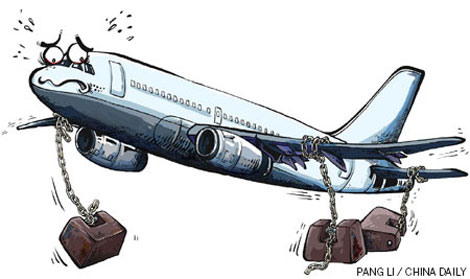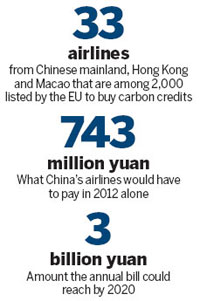Energy
EU plans may hit air pocket
Updated: 2011-05-20 11:03
By Li Jing (China Daily European Weekly)

Carbon emission charges will drastically increase operating costs for chinese carriers
Watch out, frequent travelers between China and Europe. You may have to pay more for flights starting next year to offset your carbon footprint. The European Union has set Jan 1 as the starting date for all flights, incoming and departing from the continent, to meet emission limits or pay penalties for breaking them.
The four Chinese airlines - Air China, China Eastern Airlines, China Southern Airlines and HNA Group - that operate flights between China and Europe have been asked to abide by the rule.
The airlines have protested strongly, criticizing the EU's emission program as a "unilateral and indirect" mechanism that violates widely accepted principles on fighting climate change. However, experts say China's chances of being exempted from the program are slim.
This is the first time that China's companies have been assigned the same obligations to deal with carbon emissions as their competitors in industrialized nations. China is still a developing nation, but experts say that as one of the world's top carbon emitters it should prepare for similar challenges in the future.
 |
They say the program fails to reflect the differences in responsibilities for developing and developed countries in the fight against climate change, where only the rich groups are obliged to cut their carbon emissions.
"The EU needs to take into account the different development status of countries," Li Jiaxiang, head of the Civil Aviation Administration of China, said on May 10 in Beijing.
Days before the remark, China Air Transport Association (CATA) issued a more blunt statement declaring the Chinese industry does not recognize a unilateral mechanism that "violates international aviation convention and intrudes into China's national sovereignty".
It said the association may suggest that the Chinese government take harsher countermeasures against flights in and out of China operated by airlines from EU countries.
The statement also said the EU plan is defective because it relies on indirect cap-and-trade measures that "cannot produce any direct, practical effect on energy saving and emission reduction".
Billions to pay
The EU approved a proposal in 2008 to include the aviation industry in its Emission Trading Scheme (ETS) after emissions from the sector had doubled since 1990. Such emissions account for around 3 percent of the EU's total carbon footprint.
Starting next year, airlines landing in Europe will be forced to buy carbon credits to cover each ton of carbon emission they emit in excess of the cap. The EU listed 2,000 airlines globally under its plan, with 33 of them from the Chinese mainland, Hong Kong and Macao.
EU gives exemptions for airlines whose annual carbon emissions are below 10,000 tons. That roughly equals the carbon footprint of 22 single trips between Shanghai and Brussels with a Boeing 777 aircraft.
According to the industry's calculation, China's airlines would have to pay 743 million yuan (80 million euros) in 2012 alone. If the airlines added one flight between China and Europe each week, that would add 15 million yuan to the cost. The annual bill could reach more than 3 billion yuan by 2020.
Analysts say this would dramatically increase the airlines' operation costs and hinder further development of China's burgeoning aviation industry.
The timing is problematic because major Chinese airlines are eyeing stronger expansion in overseas routes and face increased competition domestically from the spreading network of high-speed railways.
European countries are among the top destinations for Chinese travelers. For instance, Air China recently added flights to Dusseldorf, Germany, and to Milan and is planning to open new routes to Europe, according to Kong Dong, the airline's chairman.
The increased cost would likely be passed on to passengers.
"At this stage I'd say (Chinese airlines) are not going to take the step (to join the plan) as we don't recognize ETS," says Chai Haibo, CATA's deputy secretary-general. "But if finally the airlines are forced to pay for the carbon credits, I'm afraid that the travelers will have to pay more for their tickets."
Chai would not estimate the size of the fare increase, but an earlier report by China Central Television put it at 200 to 300 yuan for each single trip between China and European countries.
Domestic plan
Isaac Valero-Ladron, the European Commission's climate spokesman, said on May 11 that the EU is examining whether China could earn an exemption from the program thanks to its domestic plan. The European legislation offers an option to exclude incoming and departing flights from a non-EU country if the airline's nation implements equivalent measures to cut pollution from aviation.
"We need to analyze the details of the Chinese plan to curb emissions from airlines," he was quoted by Bloomberg as saying. "Regardless of their nationality, all carriers must be treated equally to avoid distortion of competition. We have been and will continue to be open to discuss how to best combine our efforts in addressing the impact of aviation."
China has set a target, by 2020, to reduce carbon emissions for each unit of economic growth by 40 to 45 percent from 2005 levels. As part of that move, the country's aviation regulator also asked all airline carriers to cut energy and carbon intensity by 22 percent during the same period.
Such a plan could fall short of the expectations of the EU, which prefers a cap on carbon emissions, says Zhang Jianyu, China program manager of the US-based Environmental Defense Fund.
"Even with this carbon intensity cut, China's greenhouse gas emissions in the aviation industry are still set to grow, while EU's cap-and-trade system is aimed at reducing the total amount of carbon emissions by the sector," Zhang says.
Chai says CATA sent a negotiation group to the European Commission's headquarters in Brussels in early May, but is still waiting for an official response from the EU. He is not optimistic about the result.
"The EU side said they understand our concerns, but the law to extend ETS was passed by the European Parliament, leaving little room for change," he says.
He also says CATA is prepared to sue the EU if the program includes Chinese airlines. The prospects there are not encouraging, judging from the experience of three major airlines from the United States.
United and Continental, which merged last year, and American filed a case in late 2009, at the High Court in London, against the extension of ETS to most international flights into and out of European airports. The British court referred the case nearly a year ago to the European Court of Justice in Luxembourg for a preliminary ruling. The US airlines are still waiting for a hearing date.
Specials

Suzhou: Heaven on Earth
Time-tested adages sing praises of Suzhou, and Michael Paul Franklin finds it's not hard to understand why on a recent visit.

The sky's the limit
Chinese airline companies are increasingly recruiting pilots and flight attendants as the industry experiences rapid expansion.

Diving into history
China's richest cultural heritage may lie in the deep, like exhibits in a giant underwater museum.